Search results: "rubi" 9 IDaids
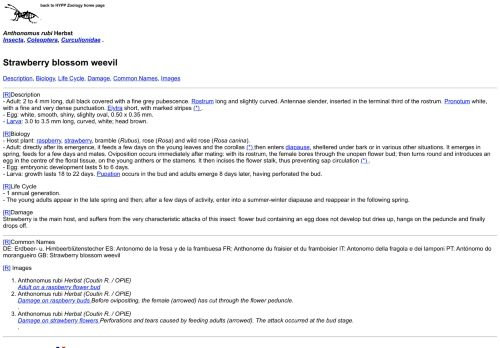
Encyclopédie des Ravageurs Européens (Encyclopedia of European Pests) - HYPPZ: Anthonomus rubi Herbst
Screening Aid/Fact Sheet/Pest Alert
Institut National de la Recherche Agronomique (INRA), France
The HYPPZ page about the strawberry blossom weevil describes its morphology, biology, life cycle, and damage.
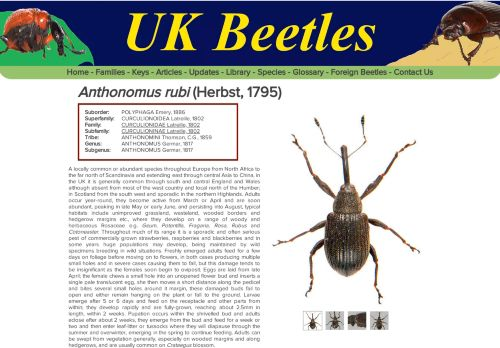
UK Beetles - Anthonomus rubi (Herbst, 1795)
Screening Aid/Fact Sheet/Pest Alert
Conall, D. and Conall, M.
This hobbyist website describes the strawberry blossom weevil's morphology, biology, and ecology and includes photos of it.
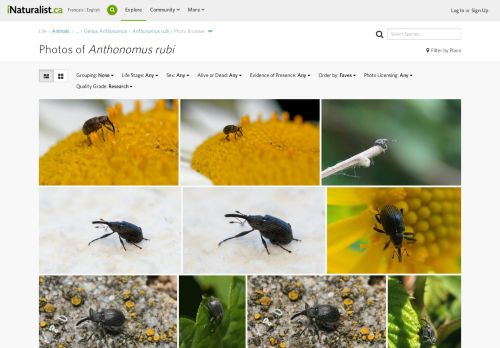
Photos of Anthonomus rubi
Image Gallery
iNaturalist, United States of America
These photos of the strawberry blossom weevil from iNaturalist are enlargeable. Click on species name at top for it's brief description, observation data, and more.
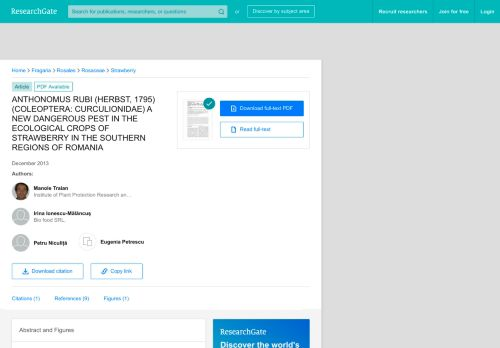
Anthonomus rubi (Herbst, 1795) (Coleoptera: Curculionidae) a new dangerous pest in the ecological crops of strawberry in the Southern regions of Romania
Journal Article
Manole T, Ionescu-Malancus I, Niculita P, and Petrescu E. 2013. Anthonomus rubi (Herbst, 1795) (Coleoptera: Curculionidae) a new dangerous pest in the ecological crops of strawberry in the Southern regions of Romania. Scientific Papers Series Management, Economic Engineering in Agriculture and Rural Development 13 (4): 201-204.
Abstract: In Romania mostly of 70% of strawberry ecological plantations were cultivated with specific commercial cultivars like Premial, Red Gauntlet, Dana and Elsanta. In the last years became to be cropped cultivars with increased resistance to various pest insects, specially in the first stages of vegetation period like Honeoye, Elsanta, Camorosa, Marmolada, Chandler, Darselect, Clery and Sonata. On the little individual farms with small surfaces the cultivars Senga Sengana, Marmolada, Elsinore should be the primary source of infestation with Anthonomus rubi. A study of distribution, density and the degree attack of Anthonomus rubi was carried out in the period 2006-2007 in the Vidra and Comana localities, Giurgiu district in the southern part of Romania. The study and observations that was made showed that this species is increased in density in the new ecological plantations of strawberry from some individual farms. The strawberry blossom weevil is not a common pest of strawberry plantations in Romania but some cultivars cropped in ecological system became more sensitive to the weevil attack by increasing in density. Observations and researches were carried out on 4 cultivars and showed that the degree of damage caused by A. rubi depends of cultivar morphological characteristics (small fruits) or phenophases (time of ripening and duration of budding and blossoming).<
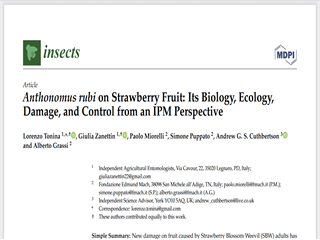
Anthonomus rubi on Strawberry Fruit: Its Biology, Ecology, Damage, and Control from an IPM Perspective
Journal Article
Tonina L, Zanettin G, Miorelli P, Puppato S, Cuthbertson AGS, and Grassi A. 2021. Anthonomus rubi on Strawberry Fruit: Its Biology, Ecology, Damage, and Control from an IPM Perspective. Insects 12 (701): 1-26.
Abstract: The strawberry blossom weevil (SBW), Anthonomus rubi, is a well-documented pest of strawberry. Recently, in strawberry fields of Trento Province (north-east Italy), new noteworthy damage on fruit linked to SBW adults was observed, combined with a prolonged adult activity until the autumn. In this new scenario, we re-investigated SBW biology, ecology, monitoring tools, and potential control methods to develop Integrated Pest Management (IPM) strategies. Several trials were conducted on strawberry in the laboratory, field and semi-natural habitats. The feeding activity of adult SBW results in small deep holes on berries at different stages, causing yield losses of up to 60%. We observed a prolonged survival of newly emerged adults (>240 days) along with their ability to sever flower buds without laying eggs inside them in the same year (one generation per year). SBW adults were present in the strawberry field year-round, with movement between crop and no crop habitats, underlying a potential role of other host/feeding plants to support its populations. Yellow sticky traps combined with synthetic attractants proved promising for both adult monitoring and mass trapping. Regarding control, adhesive tapes and mass trapping using green bucket pheromone traps gave unsatisfactory results, while the high temperatures provided by the black fabric, the periodic removal of severed buds or adults and Chlorpyrifos-methyl applicationconstrained population build-up. The findings are important for the development of an IPM strategy.
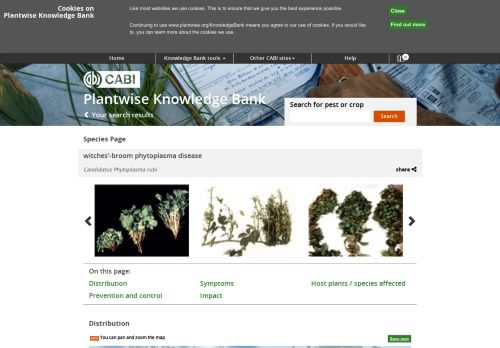
PlantwisePlus Knowledge Bank: Witches'-Broom Phytoplasma Disease (Candidatus Phytoplasma rubi)
Image Gallery, Screening Aid/Fact Sheet/Pest Alert
CABI PlantwisePlus Knowledge Bank
This species page contains photos and a description of symptoms and lists which ones manifest on which plant parts.
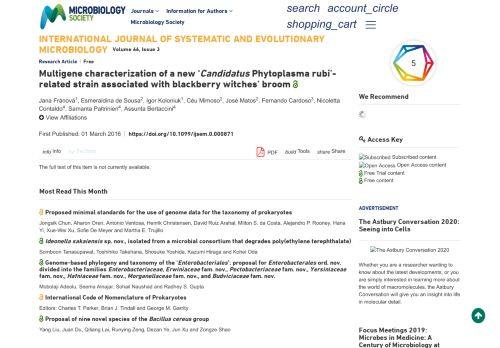
Multigene Characterization of a New 'Candidatus Phytoplasma rubi' - Related Strain Associated with Blackberry Witches' Broom
Journal Article, Molecular Data
Washington Invasive Species Council, United States of America
This objective of this study was to identify a phytoplasma expressing symptoms in blackberry and characterize it at the molecular level using RFLP and multigene sequencing analysis. Based on the results of the study, the authors propose this pathogen be classified as a novel ribosomal sub-group Candidatus Phytoplasma rubi 16SrV-I.
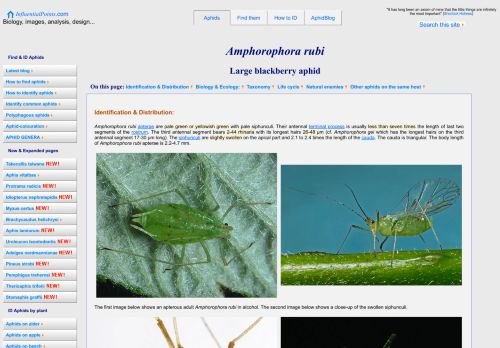
InfluentialPoints: Aphid Identification - Amphorophora rubi
Screening Aid/Fact Sheet/Pest Alert
InfluentialPoints
This large blackberry aphid fact sheet contains images and information about names, identification, distribution, biology, and ecology. Other useful links appear throughout the text.
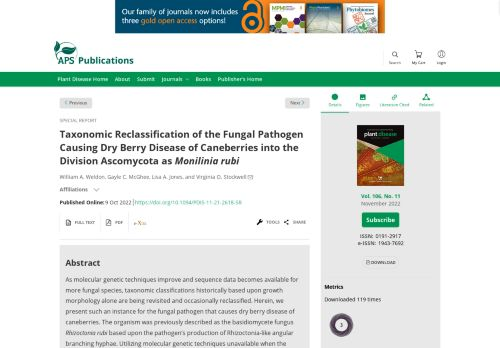
Taxonomic Reclassification of the Fungal Pathogen Causing Dry Berry Disease of Caneberries into the Division Ascomycota as Monilinia rubi
Journal Article, Molecular Data, Taxonomic Review/Revision
Weldon WA, McGhee GC, Jones LA, and Stockwell VO. 2022. Taxonomic Reclassification of the Fungal Pathogen Causing Dry Berry Disease of Caneberries into the Division Ascomycota as Monilinia rubi. Plant Disease 106 (11): 2788 – 2798.
Abstract: As molecular genetic techniques improve and sequence data becomes available for more fungal species, taxonomic classifications historically based upon growth morphology alone are being revisited and occasionally reclassified. Herein, we present such an instance for the fungal pathogen that causes dry berry disease of caneberries. The organism was previously described as the basidiomycete fungus Rhizoctonia rubi based upon the pathogen’s production of Rhizoctonia-like angular branching hyphae. Utilizing molecular genetic techniques unavailable when the pathogen was first characterized in 1959, three housekeeping gene regions (ITS, ß-tubulin, and G3PDH) were sequenced across 13 contemporary dry berry isolates, as well as the original 1959 R. rubi type strain, CBS382.59. The resulting neighbor-joining, maximum likelihood, and Bayesian phylogenies for single and multilocus sequences provide strong evidence that the dry berry pathogen was misclassified. This data, in addition to revisiting in vivo macroscopic and microscopic growth morphology, again comparing contemporary dry berry isolates to the CBS382.59 type strain, suggests that the causal organism is a new species within the genus Monilinia that we propose be classified as Monilinia rubi. A transition from designation as a basidiomycete fungus to an ascomycete fungus could have implications on chemical management decisions, as well as the assumptions made about cell structure and the pathogen’s putative life cycle.
